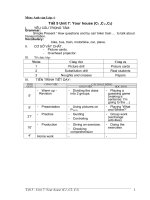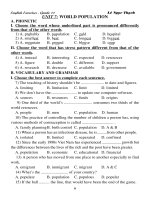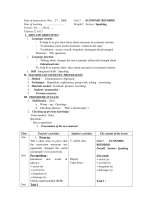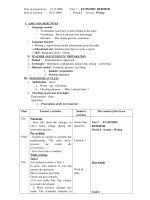Unit 7. Celebrations
Bạn đang xem bản rút gọn của tài liệu. Xem và tải ngay bản đầy đủ của tài liệu tại đây (1.66 MB, 8 trang )
Unit 7
Reading
Before Reading
Match the appropriate celebrations with the suitable day
1. Vietnamese
National Day
a. August 15th
on the lunar
calendar
2. King Hung’s Death
Anniversary
b. November 20th
3. Mid-Autumn
Festival
c. January 1st on the
lunar calendar
4. Vietnamese New
Year’s Day
d. September
2nd
5. Vietnamese
Teachers’ Day
e. March 10th on
the lunar calendar
1.d
2.e
3. a
4. c
5. b
VOCALBULARY
to fast (v) / fɑ:st /: to practice abstinence as a religious exercise or duty ( nhịn ăn )
procession (n) / prə'se∫n / : a train of persons advancing in order (đòan diễu hành )
to mourn (v) / mɔ:n /: to express or to feel grief or sorrow (than khóc)
to deem (v) / di:m /: to think ; to judge( cho rằng, nghĩ rằng )
candied (a) / 'kændid /: preserved in or with sugar; incrusted with a candylike
substance; as, candied fruits (mứt)
ornamental (a) / ,ɔ:nə'mentl /: beautifying ( để trang trí )
ancestor(n) / 'ænsistə / : one from whom a person is descended, an earlier type
( ông bà tổ tiên )
unicorn (n) / 'ju:nikɔ:n /: a fabulous animal with one horn ( con kì lân )
repentance (n) / ri'pentəns /: regret( ăn năn, hối lỗi )
bud (n) / bʌd / : a branch of a flower ( nụ hoa )
New Year’s Celebrations Around the World and in Viet Nam
In Europe and the United States, New year’s Day is observed on the 1st
of January, which was named for Janus- the Roman god of door and of
beginnings. If the Gregorian calendar had not been introduced in 1582,
Westerners would instead have had their New Year’s celebrations on
March 25th, a tradition that had previously lasted for centuries. On their
New Year’s Eve, bells are rung, horns blown, wishes exchanged, and
resolutions mad at midnight.
In the middle East, the Shiite have Muharram through the first ten days
of Muharram, the first month of the Islamic canlendar. During in
celebration, processions from different villages gather and people
mourn by beating their chests. Similarly, the Jewish Rosh Hashanah,
which takes place in the month of Tishri (September or October on the
Gregorian calendar), is a very solemn holiday set aside for fasting and
repentance.
In Viet Nam, Tet Nguyen Dan takes place in the first month of the Lunar
calendar- from late January to early February. As preparations, people
are busy buying things preparing traditional foods, and cleaning the
house. “Must-have” items deemed to be bought or prepared are cakes
made from sticky rice, dried watermelon seeds, fruits (fresh and
candied), tea, alcoholic and soft drinks, ornamental plants, and flowers.
On New Year’s Eve, people make offerings to their ancestors, go to
church or pagoda, or go out to pick buds or young leaves. For the New
Year’s first three days, Vietnamese visit family members, neighbors,
teacher, friends, and graves of ancestors. Only best wishes and positive
comments are expectedly exchanged, for people believe that they would
be haunted by bad luck for the rest of the year if these first days were
not filled with joy or good news. Children receive their li xi or tien mung
tuoi- “lucky money” normally in red envelopes. Across the country,
festivals, games, and various forms of entertainment are held and
traditional specialties such as wrestling, buffalo fighting, or dragon or
unicorn dancing may take place in different regions.
a) Fill the table with the information from the text
New Year’s Celebrations Around the World
Culture
Western
(European &
American)
Middle East
Jewish
Vietnam
What?
New
Year
Muharram
Rosh
Hashanah
Tet
Nguyen
Dan
When?
1st of January
Activities
Ringing bells, blowing horns &
exchanging wishes
and making resolution
1st month
of Islamic
calendar
September or
October on the
Gregorian
calendar
From late
January
to early
February
Processions from different villages gather
Beating chests
Fasting and repenting
Making offerrings to their ancestors, going to
church or pagoda or going out to pick buds or
young leaves
Visiting family members, neighbors, friends and
graves of ancestors
Exchanging wishes and positive comments
Holding traditional specialties such as wrestling,
buffalo fighting or dragon or unicorn dancing
b) Answer the following questions.
1. How long has January 1st been New Year’s Day?
2. What is the origin of January?
3. Do Shiite people calebrate their New Year in
January?
4. What month on the Gregorian calendar does Tishri
normally fall on?
1. For 425 years.
2. It was named for Janus- the Roman god
of doors and of beginnings.
3. No, they don’t.
4. September or October on the Gregorian
calendar.
5. Who may get li xi or tien mung tuoi? What is
it?
Children get lixi/ tien mung tuoi which is
“lucky money” normally in red envelopes.
6. It can be inferred from the text that the
following may be among foods and drinks
typically served during Tet.
• Glutinious rice cakes
• Candied ginger
• Coke
• Beer
• fruits, tea
7. What are Tet Nguyen Dan’s traditional forms
of entertainment mentioned in the text?
• Dragon/unicorn dancing
• Wrestling
• Buffalo fighting
8. What is the key difference between Shiite
and Jewish New Year observances and those
of other countries described in the text ?
Shiite and Jewish New Year observances: is a
solemn holiday set aside for fasting and
repentance.
Those of other countries: is a joyful holiday
with wishes exchanged .
9. People often make New Year’s resolutions,
promising to improve themselves in one way
or another. Do you? If yes, how successful
have you been carrying them out?
Yes, I do. I’ve been studying harder, obey my
parents and respect to the old to make my
parents pleased and happy.









